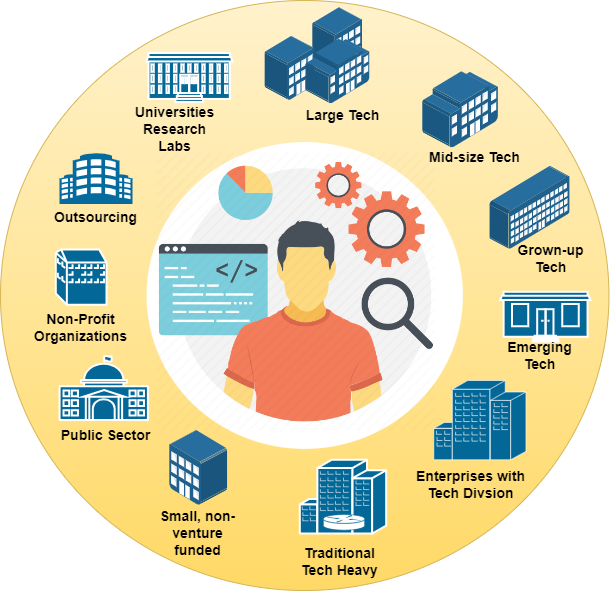Tech Firms Classifications in a Software Engineer’s point of view

Recently I have started reading few books to hone my skills and knowledge to meet the trending shock in the software Industries. An extract my understanding on how a Software Engineer can see the industry in a job point point of view
1.Large Tech Firms
These are big, publicly traded businesses. Their market capitalization is in the billions, and they normally employ thousands of software engineers.
Big Tech engineering positions are typically in high demand because of their competitive pay, opportunity for career advancement above engineer level, and ability to work on projects that affect hundreds of millions of users. Additionally, there may be the chance to collaborate with top-tier colleagues from various industries.
2.Mid-sized Tech Firms
Software engineering is the foundation of tech-first companies. Thousands or even hundreds of software engineers may be employed by these smaller, non-Big Tech companies. These businesses typically provide career paths beyond the engineer level and pay comparable to Large Tech. Even though the user bases are typically smaller, engineers’ work can nevertheless have an impact on tens of millions of users through their projects.
3.Grown-Up Tech Firms
Later-stage, venture-funded businesses that have a good fit between their product/services and market. which is funding expansion. These companies might intentionally be losing money to invest in expanding their market share.
These organizations typically operate quickly under intense pressure to expand the company to meet valuation requirements, profit from upcoming funding rounds, or get ready to go public.
“Unicorn” companies, which have a private valuation of at least $1 billion, are a subset of grownup. Being on indicated a company might be the next big thing ten years ago, when there were comparatively fewer unicorns. Today, unicorns are much more common, so being one makes a company less unique.
4.Emerging Tech Firms
Businesses that have received venture capital funding and are pursuing a product-market fit. This is creating a product that consumers will want to buy.
Startups are by nature risky; in order to survive, they frequently generate little revenue and must find new funding rounds, which require a product market fit.
Software engineers typically have the most freedom—and the least stability—at startups. These businesses may also have strict policies regarding work-life balance because their survival depends on developing a product market before their funding runs out. In the meantime, a startup’s environment is greatly influenced by its founders. A “work hard, play hard” mentality was instituted by some. However, concentrate on a sustainable workplace culture. Startups provide the widest range of jobs and labour force and growth opportunities.
5.Traditional Non-tech Firms with tech divisions
These establishments are mostly focused on another sector, which has little to do with technology. Some were established prior to the software era and are older than fifty years. Others work in fields where the primary source of value is not technology. Many of these organizations have started the digitization process with the goal of turning software development into a more strategic endeavor. But these businesses tend to pay less than large tech corporations because technology is more of a cost centre than a profit centre. However, compared to most tech-first organizations, These tend to offer better work-life balance and more job stability. The drawback for software engineers is that they typically have fewer career alternatives than Large Tech and Grown-up firms.
6.Traditional Technology heavy Firms
Businesses that focus heavily on technology, whether it be in the form of software, hardware, or both, make up an intriguing subgroup of more conventional businesses. These enterprises are now established, dependable, and lucrative ventures that were frequently exceptional successes in their early years. However, compared to younger technology organizations, they have a more inflexible organizational structure because of their age and slower growth. However, these organizations do provide challenging technical projects that can make working as an engineer extremely fulfilling. The scope of the job you do can also be rather large, more in line with Big Tech. Software engineers at these firms can also hold unusually long tenures, which further enhances predictability and stability.
7.Small, non-venture funded Firms
Smaller enterprises without venture capital backing include those that are bootstrapped, family-run businesses, and lifestyle businesses. These tiny businesses rarely see rapid growth and take a cautious approach to hiring and running their operations. However, owing of their profitability, reasonable work pace, and the fact that many employees choose to stay longer at stable organizations than at busier ones, they can be pleasant and reliable places to work.
8.Public Sector Firms
The government is consistently asked to invest in software development, and they comply. The benefits of working in the public sector include stability, compensation that is typically well-communicated and based on a formula, and most positions offer good benefits and paid time off. Drawbacks could include the necessity to maintain antiquated systems that are difficult to update and a sluggish, bureaucratic approach. It may also be more difficult in some nations to go from public to private employment.
9.Nonprofits Firms
These are in place to support social and public causes. Venture-funded businesses offer more salary than nonprofits. However, their goal is not the same as that of making money for owners and investors. There are differences in work settings, and some are great for engineers to work in. But technology is more of an expense.
10. Outsourcing Firms
Hiring software engineering talent from an agency or outsource provider is in high demand. The number of software engineers that outsourcing businesses supply is determined by the customer, who chooses how to use the engineering talent inside its own organization. Meanwhile, a consultancy provides the software engineers needed to complete complex projects from start to finish, and it enters contracts with clients for this kind of work. The outsourcing firm usually in charge of project construction and delivery Typically, outsourcing firms are small to midsize businesses that take on smaller consulting projects for clients, such as developing websites, apps, and other related projects. They are also capable of managing client service and maintenance. Consultant engineers work full- time for the development agency and frequently bill clients on a daily or hourly basis. Typically, outsourcing firms are small to midsize businesses that take on smaller consulting projects for clients, such as developing websites, apps, and other related projects. They are also capable of managing client service and maintenance. Consultant engineers work full-time for the development agency and frequently bill clients on a daily or hourly basis. Outsourcing firms provide software engineers the benefit of being the easiest places to get hired. This is since these businesses frequently have a strong demand for talent and pay less than their counterparts in other areas.
Additional benefits include the availability of training for engineers with less experience and the chance to work on a range of projects.
11.Research labs
These organizations typically participate in long-term research initiatives and collaborate closely with universities. While some specialize in basic research, others conduct applied research.
The opportunity to apply your knowledge to less explored subjects and the steadiness of working in a setting free from commercial demands are two benefits of working in research labs.
Conclusion
Which of the many corporations and organizations that consider software engineers fits you the best, given the variety of options available? All 11 of the above-mentioned categories of places are unlikely to present chances at the same time. So, to reduce the list to manageable possibilities based on your situation, it can be useful to speak with friends, relatives, and other engineers in your network. Ask them about their impressions of their workplace and the actual nature of their job, if possible.
Remember that teams within the same company might differ greatly, and there can be large disparities across firms in the same sector. A member of a successful team in the IT division of a traditional firm is probably having a better time than a member of a failed team at a Big IT Tech.
Reference : Book : The Software Engineer’s Guidebook (First Edition: November 2023) by Gergely Orosz













